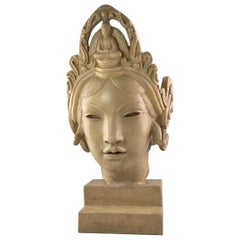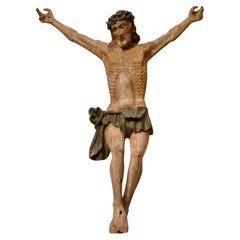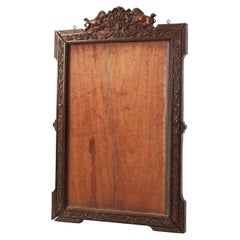Want more images or videos?
Request additional images or videos from the seller
1 of 9
20th Century Japanese Style Cast Iron Heron
$767.20List Price
About the Item
- Dimensions:Height: 6.11 in (15.5 cm)Width: 2.92 in (7.4 cm)Depth: 4.34 in (11 cm)
- Style:Japonisme (In the Style Of)
- Materials and Techniques:
- Place of Origin:
- Period:
- Date of Manufacture:First half 20th Century
- Condition:Wear consistent with age and use.
- Seller Location:Stockholm, SE
- Reference Number:1stDibs: LU1006844712112
About the Seller
4.9
Recognized Seller
These prestigious sellers are industry leaders and represent the highest echelon for item quality and design.
Established in 1989
1stDibs seller since 2013
108 sales on 1stDibs
Authenticity Guarantee
In the unlikely event there’s an issue with an item’s authenticity, contact us within 1 year for a full refund. DetailsMoney-Back Guarantee
If your item is not as described, is damaged in transit, or does not arrive, contact us within 7 days for a full refund. Details24-Hour Cancellation
You have a 24-hour grace period in which to reconsider your purchase, with no questions asked.Vetted Professional Sellers
Our world-class sellers must adhere to strict standards for service and quality, maintaining the integrity of our listings.Price-Match Guarantee
If you find that a seller listed the same item for a lower price elsewhere, we’ll match it.Trusted Global Delivery
Our best-in-class carrier network provides specialized shipping options worldwide, including custom delivery.You May Also Like
Vintage Cast-Iron Eagle Sculpture, Early 20th Century
Located in Colorado Springs, CO
This is a cast-iron figural eagle doorstop, circa early 20th century. The eagle is depicted with wings spread wide, perched and mounted to a square marble base. The eagle retains traces of its original gilt surface and is embossed with “F.O.E.” at its midsection, possibly referring to the Fraternal Order of Eagles.
The eagle is both the national bird and the national animal of the United States. The eagle motif has been widely used throughout American history, most notably as part of our Great Seal. The founders of the United States were fond of comparing their new republic with the Roman Republic, in which eagle imagery, usually the golden eagle, was prominent. On June 20, 1782, the Continental Congress adopted the design for the Great Seal of the United States...
Category
Early 20th Century American Federal Animal Sculptures
Materials
Marble, Iron
20th C Cast Iron Cat Boot Scrape
Located in Los Angeles, CA
20th C cast iron cat boot scrape.
Category
Early 20th Century American Adirondack Antiquities
Materials
Iron
Pair of French 19th-20th Century Neoclassical Style Cast Iron Figural Torchères
Located in Los Angeles, CA
A very fine pair of French 19th-20th century neoclassical style patinated cast iron figural torchères by A. Durenne, Paris, each representing a figure of a standing young maiden, her arms raised forward while holding a a flaming urn gas light (Now electrified) with a frosted glass flame, each raised on a veined grey marble column stand, both cast-signed 'A. Durenne, Paris'. Antoine Durenne was an internationally renowned French art founder. He attended École Nationale Supérieure des Beaux-Arts in 1842. Durenne purchased a small foundry in Sommevoire, near the Val d'Osne, Haute-Marne, France and established The Durenne firm, circa Paris, 1900.
Cast-iron had been in production during the 18th century but its inferior status to the more fashionable and delicate wrought iron had generally confined its use to architectural work. By the early 19th century, however, rapid developments of the Industrial Revolution combined with the simultaneous burgeoning of a new middle class provided the impetus for a dramatic Expansion in its application and in a short space of time a proliferation of iron foundries across Europe and America thrived on the production of everything from inkstands to railway stations. The use of cast-iron for garden ornament became particularly widespread at this time, as the possibilities for its mass-production at a fraction of the cost of bronze made it the material of choice for outdoor statuary...
Category
Antique Early 1900s French Neoclassical Revival Figurative Sculptures
Materials
Marble, Iron
$49,875 Sale Price / set
41% Off
H 71 in W 29 in D 27.5 in
Pair of Early 20th Century Lead Herons
Located in Gloucestershire, GB
Pair of early 20th Century lead herons in differing poses.
They are on original composite stone bases in original condition retaining lichen and patina.
Circa 1900.
One heron is: 13...
Category
Early 20th Century English Animal Sculptures
Materials
Stone, Lead
Early 20th Century Chromed Cast Iron entitled "Turning Panther"
Located in London, GB
A striking pair of early 20th Century chromed cast iron sculptures modelled as two turning panthers in mirroring poses, stamped with diamond lozenge export/import marks
ADDITIONAL I...
Category
Early 20th Century French Art Deco Animal Sculptures
Materials
Chrome, Iron
Heron ii, Sculptor by Marion Smith, 20th Century
Located in Faversham, GB
The graceful ‘Heron II’ by internationally renowned sculptor Marion Smith. Lifesized and made of bronze resin with signature and initials of Marion Smith to the base. Marion’s works ...
Category
20th Century British Mid-Century Modern Animal Sculptures
Materials
Resin
$2,910 Sale Price
20% Off
H 35.83 in W 16.15 in D 7.88 in
Vintage Bronze Heron Sculptural Pond Fountain 20th Century
Located in London, GB
A truly stunning large vintage bronze Heron sculptural pond fountain, late 20th century in date.
This is a beautiful garden pond fountain sculpted in bronze with contrasting brown a...
Category
Vintage 1980s English Animal Sculptures
Materials
Bronze
Japanese Ikebana Iron Vase, Japan, 20th Century
Located in San Juan Capistrano, CA
Japanese Ikebana Iron Vase, Japan, 20th Century.
Category
20th Century Japanese Japonisme Vases
Materials
Iron
Early-Mid 20th Century English Scottie Dog Cast Iron Doorstop
Located in Chapel Hill, NC
Early-mid 20th century Scottie Dog cast iron doorstop, English. Simply adorable in original black paint with expected wear - sitting up for attention. Well modelled.
14" h., 8 5/8" w...
Category
Early 20th Century English Animal Sculptures
Materials
Iron
A Rare Pair of 20th Century Animalier Cast Iron Hunting Dogs
Located in Dublin, IE
A rare pair of 20th Century animalier heavy cast iron sculptures depicting hunting dogs after H. Alfred Jacquemart (1824-1896), the leading contributor to French animalier school of ...
Category
Mid-20th Century French Animal Sculptures
Materials
Iron
More From This Seller
View AllEarly 20th Century Swedish Plaster Sculpture, Art Deco, signed Strindberg
By Tore Strindberg
Located in Stockholm, SE
This is a study for one of the figures that is part of Tore Strindbergs large sculpture "The five continents" placed in Gothenburg, Sweden. This one represents Asia.
The sculpture ...
Category
Vintage 1920s Swedish Busts
Materials
Plaster
15th Century Corpus Christi Wood Sculpture
Located in Stockholm, SE
Rare late 15th century or early 16th century Gothic Corpus Christi wood sculpture. Probably North German or South Sweden. This large Christ sculpture...
Category
Antique 15th Century and Earlier German Gothic Figurative Sculptures
Materials
Wood
18th century Venus de’ Medici Bronze Bust
Located in Stockholm, SE
An 18th century Venus de’ Medici bronze bust, mounted on a later 19th century marble base. It has a beautiful rich slightly worn dark brown patina. Venus...
Category
Antique 18th Century Italian Classical Roman Busts
Materials
Marble, Bronze
19th or 20th Century Antique Asian Mirror Frame
Located in Stockholm, SE
A large 19th or 20th century Asian, possibly Chinese, carved mirror frame. Heavy Asian wood. The top with carving similar to a crest and two Foo dogs facing each other. Probably made...
Category
Early 20th Century Asian Chinese Export Furniture
Materials
Wood
Mid -20th Century Tray Table Yngvar Sandström Trivia. NK Workshops
By Yngvar Sandström
Located in Stockholm, SE
A fine Scandinavian Modern bedside or bed tray table "Nikko" by the well known Swedish workshops of NK, ( Nordiska Kompaniet ) after a design by Yngvar ...
Category
Mid-20th Century Swedish Scandinavian Modern Tray Tables
Materials
Oak, Teak
$911 Sale Price
20% Off
Grand Tour sculpture of Narcissus, 19th c
Located in Stockholm, SE
This elegant 19th-century Grand Tour bronze sculpture represents Narcissus, the character from Greek mythology known for his beauty and self-admiration. Standing 65 cm high, the figu...
Category
Antique Mid-19th Century Italian Figurative Sculptures
Materials
Bronze
Recently Viewed
View AllMore Ways To Browse
White Heron
Japanese Bear
Antique Japanese Cast Iron
Heron Japanese
Iron Heron
Resin Birds
Ronzan Ceramic
Stag Bronze Sculpture
Vintage Ceramic Deer
Whimsical Animal Sculptures
Whimsical Hand Painted Furniture
Wood Panther
Wood Pig
Abercrombie And Fitch Leather Animals
Antique Sculptures London
Art Deco Black Horse
Bird Figurines Italian
Bronze Horse Head



